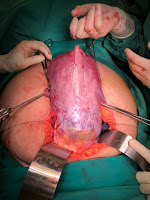The management of an elongated cervix depends on the underlying cause, severity of symptoms, and patient preferences. Here’s an overview of management of this condition.
Consent from patient has been obtain to publish this picture .
1. Conservative Management
• Asymptomatic Cases: No treatment is needed if the elongated cervix is incidental and not causing issues.
• Monitoring: Regular follow-ups with pelvic exams and ultrasound if necessary.
2. Symptomatic Cases
• If associated with pelvic organ prolapse (POP)
• Pessary: A vaginal pessary can provide support and reduce symptoms.
• Pelvic Floor Exercises: Strengthening the pelvic muscles may help mild cases.
• If associated with cervical hypertrophy or elongation in young women
• Often seen in congenital conditions; typically managed conservatively unless symptomatic.
3. Surgical Management
• Cervical Amputation (Tracheloplasty)
• Indicated for significant elongation causing prolapse, dyspareunia, or hygiene issues.
• Can be done via Manchester-Fothergill procedure (preserving the uterus) or as part of a hysterectomy if prolapse is severe.
This picture is copied from Google platform. Like to the the publisher of this picture. This article is for education purposes.
• Hysterectomy
• Considered if the patient has uterovaginal prolapse or does not desire future fertility.
4. Special Considerations
• Pregnancy:
• If elongation is causing cervical incompetence, a cervical cerclage may be required.
• If it’s not affecting pregnancy, conservative management is preferred.
Manchester - Fothergill Operation
Indication:
• Cervical elongation causing symptoms (e.g., prolapse, hygiene issues, discomfort).
• Desire to preserve the uterus.
Procedure:
• Typically performed vaginally.
• The elongated portion of the cervix is excised.
• The remaining cervix is sutured to restore normal anatomy.
Post Manchester -Fothergil operation . The red mark is the excised portion of cervix . Trans abdominal or vaginal US can provide visual picture of the operation.
Variants:
• Manchester-Fothergill Procedure
• Suitable for cervical elongation with mild to moderate uterine prolapse.
• Involves cervical amputation, shortening of the uterosacral ligaments, and suturing to reinforce support.
• Uterus is preserved, maintaining fertility.
• Shirodkar-Trendelenburg Procedure (for pregnancy concerns)
• Involves cervical amputation with cerclage placement to prevent cervical incompetence in future pregnancies.
Postoperative Care:
• Antibiotics if needed.
• Pelvic rest for 4-6 weeks.
• Follow-up to assess healing and prevent stenosis.
.Sitz bath












